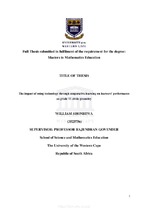| dc.description.abstract | Euclidean geometry was recently re-introduced as a compulsory topic in the Mathematics
Curriculum for learners in the Further Education and Training (FET) band in 2012. The
diagnostic analysis reports on the National Senior Certificate (NSC) Mathematics Paper 2
examinations since 2014 has repeatedly expressed concern of the poor performance of leaners
in proof and reasoning items linked to circle geometry. Various efforts have been made to
examine the composition of the curriculum to find ways of motivating learners in the study of
circle geometry and enhancing their performance but not much has been realized. The use of
technology or cooperative learning approaches for the teaching of geometry is beneficial for
pedagogical purposes, particularly for improving learners’ performance in geometry. Hence,
this study investigated the impact of using technology through cooperative learning on
learners’ performance on grade circle 11 geometry. It was thus an attempt to focus on blending
these two teaching methods with an emphasis on the use of technology. The research took place
at a Khayelitsha school and the scope of technology was limited to using a mathematical
computer programme called Heymath.
This research was grounded on the cognitive level framework that is used by the Department
of Basic Education (DBE) in the setting of National Senior examination mathematics papers,
as well as the set of social constructivist views of mathematics teaching and learning. In the
case of the latter, both social constructivism and cognitive constructivism views were
considered and applied for the purposes of this study. Using a positivist paradigm, this
convergent parallel mixed methods study employed a quasi-empirical design, where the control
group consisted of a group 26 grade 11 learners who were comparable to the group of 27 grade
learners that made up the experimental group. | en_US |

